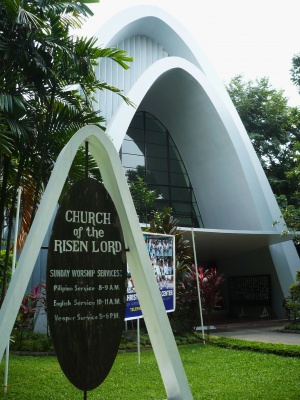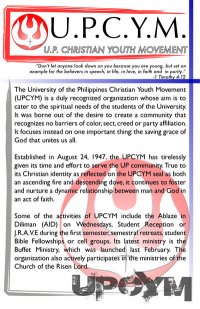Church of the Risen Lord
Places of Worship
Art Studies 2 THR-2
Prof. Roberto G. Paulino
Espiritu, Angelica E.
Mondarte, Evan Q.
Sarmiento, WillJ C.
The Church of the Risen Lord is a Protestant church located at the University of the Philippines, Diliman, Quezon City. It arose about 50 years ago through a Protestant student group named the Christian Youth Movement (CYM).
Location
The Church of the Holy Sacrifice is located in UP Diliman, along Laurel Avenue, Diliman, Quezon City, Metro Manila, beside the Parish of the Holy Sacrifice and the UP Health Service. <googlemap lat="14.659534" lon="121.07204"></googlemap>
History
Earlier years (Pre-construction of church)
In 1947, when the University of the Philippines was still in Padre Faura, Manila, a group of Protestant students started a movement named Christian Youth Movement (CYM) which aims to “make relevant Christian presence in the university campus”. They sought help from the Philippine Federation of Christian Churches (PFCC), now the National Council of Churches in the Philippines (NCCP).
When the Diliman campus became the main campus of UP in 1949, the UPCYM also transferred to Diliman. With the new university setting, they stayed at a sawali chapel – a chapel made of bamboo and nipa - and shared it with two other religious groups, namely the UP Student Catholic Action (UPSCA) and the Iglesia Filipina Independencia.
Eventually, these three religious groups started to have conflicts among their schedules, like for the Protestant worship services and the Catholic masses. Also, each group started to receive more and more members, making the chapel too crowded to accommodate all of them. So in 1952, the UPCYM launched their own fund drive, for them to be able to build their own Protestant chapel and student center inside the campus. March 16 of that year, they held a concert at the Central Church, Manila, with Ramon Tapales and Flora Zarco-Rivera of the UP Conservatory of Music and Luz Morales of the Centro Escolar University as conductors.
In 1953, Cesar Cancio and his architectural firm presented proposed blueprints for the Church and the student center to the NCCP and the UP Regent of Boards. The following year,1954, the Church of the Risen Lord and the Student Center was built. Its groundbreaking ceremonies were held on February 7 of that year.
After grounbreaking ceremonies
1956
- First CRL constitution drafted
- Christian Women's Fellowship (now Christian Women's Guild) organized
1958
- CRL requested for recognition as a local church
- Request was later denied but CRL was still allowed to exist as a STUDENT MINISTRY
1961
- Nursery-Kindergarten School started
1963-1972
- DYNAMIC DECADE: Many new evangelical expressions
- "Passion According to St. Matthew" (1964) and "Passion According to St. John" (1965) marked ecumenical reach-out and participation of both churches (Church of the Risen Lord and Parish of the Holy Sacrifice in the premier state university campus.
1964
- Student Center renamed Gumersindo Garcia Fellowship Hall
1969
- First Filipino chaplain: Rev. Bonifacio Mequi
Architectural structure

The Church of the Risen Lord was designed to have an exterior shape similar to a parabola. This kind of architectural design symbolizes the belief that there are imperfections outside the Christian world and all of our aspirations to be perfect are useless. A characteristic of a parabola is that it has no distinctive peak just like of a triangle and it has no one slope. As we go up the parabola, before we get to the highest peak, we can observe that we eventually go down.
Also, entering in the church represents the desire to partake the God’s Bread of Life, which symbolizes God’s spiritual being. As we continue to go to the chancel (similar to the altar of the Catholics but has no visual representations of holy beings) – the salvation despite the imperfections in the real world, we can observe that the width of the church is tapering and this represents the one true path/direction towards the chancel (the salvation).

Moreover, the seal of the UPCYM group can be seen as an ascending fire or can also be a descending dove. This symbolizes the spiritual connection between God and the human being. The fire is associated to the faith of the human to his creator and the dove represents the love of God for us.
Other parts of the church
The church is comprised of a main chapel (Church of the Risen Lord), a student center (Gumersindo Garcia Hall) and a child care center (Christian Child Care Center).
Christian Child Care Center (CCCC)
The Christian Child Care Center is a school that gives scholarships to children from needy families in university communities. It was originally named Nursery-Kindergarten School when it was started in 1961.
Gumersindo Garcia Hall (GG Hall)
The Gumersindo Garcia Hall (most commonly known as the GG Hall) is the student center of the CRL. It was named after Dr. Gumersindo Garcia, the UP Regent who persuaded the UP Administration and UP Regent of Board to allow the building of the Protestant chapel and student center. It was his through his efforts that the chapel and student center was allowed to be built in the university grounds.
When Dr. Garcia passed away in April 8, 1964, the student center was renamed Gumersindo Garcia Fellowship Center to dedicate his memory. Later, it was changed to its present name, Gumersindo Garcia Hall or GG Hall, as what is more commonly known to the community.
References
UP Chapel and the Church of the Risen Lord


